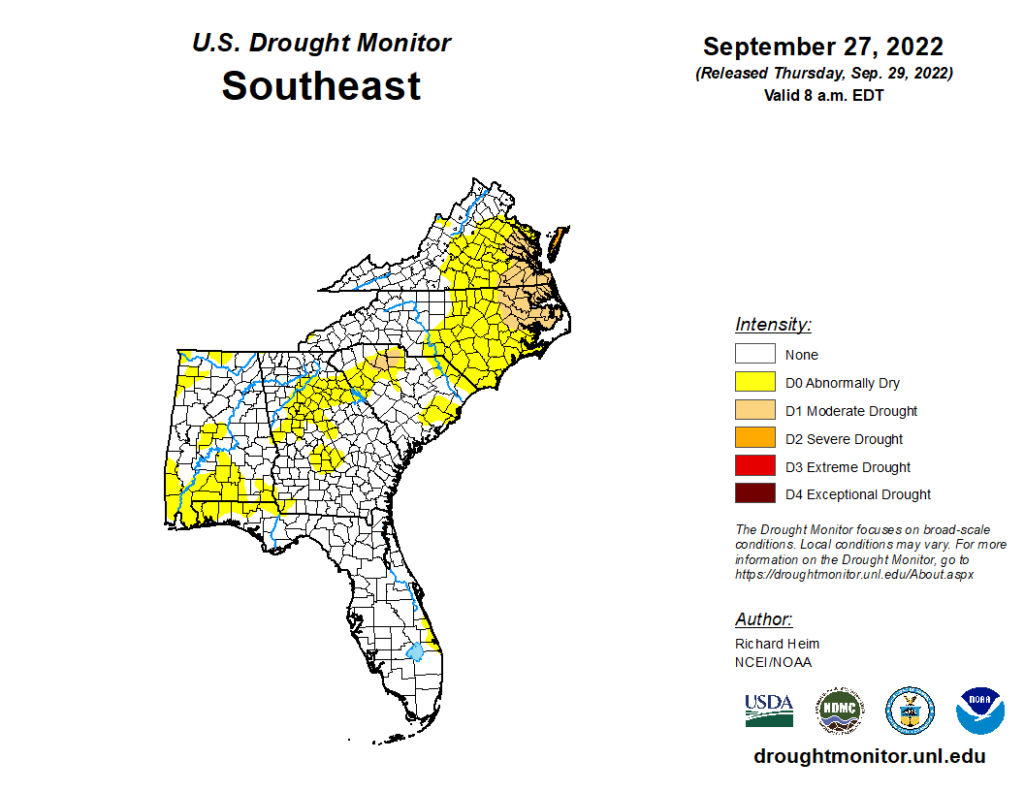
By Clint Thompson
Abnormally dry conditions are starting to worsen in counties across Alabama and Georgia, while only a small portion of the Florida Panhandle is abnormally dry. Florida mostly has sufficient moisture following Hurricane Ian last week. This is according to the U.S. Drought Monitor.
Alabama Conditions
Alabama’s dry conditions are located mostly in the southwest part of the state in Mobile and Baldwin counties, stretching northward to Choctaw County and eastward to Henry and Houston counties; in central Alabama in Perry, Bibb and Chilton counties; and in northwest Alabama in Lamar, Marion, Franklin, Lawrence, Colbert, Lauderdale, Limestone and Madison counties.
Georgia Conditions
Georgia’s abnormally dry conditions are isolated mostly to the central and northern areas of the state, starting in Harris County, stretching eastward to Lincoln, Elbert and Hart counties and northward to Forsyth and Hall counties. Houston, Bleckley, Dodge, Pulaski, Dooly, Crisp and Wilcox counties are also abnormally dry.
Florida Conditions
Florida’s abnormally dry conditions are located in the Panhandle, starting in Escambia County and stretching eastward to Jackson and Gadsden counties. A small portion of Indian River, Saint Lucie and Martin counties along the Atlantic Coast are abnormally dry as well.
The recent uptick in dry weather goes along with activity being experienced in other parts of the country, says U.S. Department of Agriculture meteorologist Brad Rippey.
“During the four-week period ending Sept. 27, we saw a 5.4 percentage point increase in U.S. drought coverage from 45.5% on Aug. 30 to 50.9% on Sept. 27. It makes it the first time since early August that we’ve seen U.S. drought coverage back up above 50%. We’re heading in the wrong direction in terms of this drought for the vast majority of the country,” Rippey said.
“Areas that experienced deterioration in terms of the drought situation during the month of September included the Great Plains, the Northwest, the Western Corn Belt and also an area along the Atlantic Coast from Georgia to Virginia. That’s actually a positive because it allowed soils to dry out in advance of the approach of the remnants of Hurricane Ian. It should help to limit some of the flooding that would have occurred if it had been much wetter like Florida has been. Florida soils were much wetter in advance of Hurricane Ian and that resulted in extensive flooding there.”
Most of the western region of South Carolina is either abnormally dry or moderately dry, especially in Laurnes, Spartanburg, Union, Chester and York counties.
The entire eastern region of North Carolina is either abnormally dry or moderately dry. It’s especially challenging in areas as far south as Pitt and Beaufort counties and stretching northward to Halifax, Northampton, Hertford, Gates, Camden and Currituck counties.









